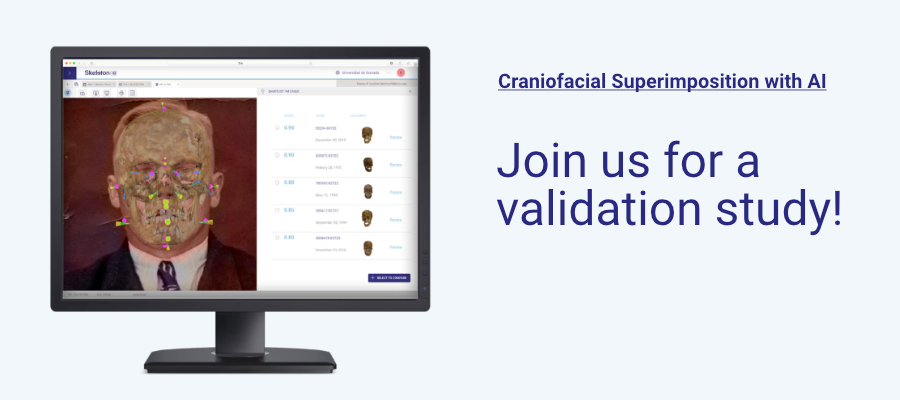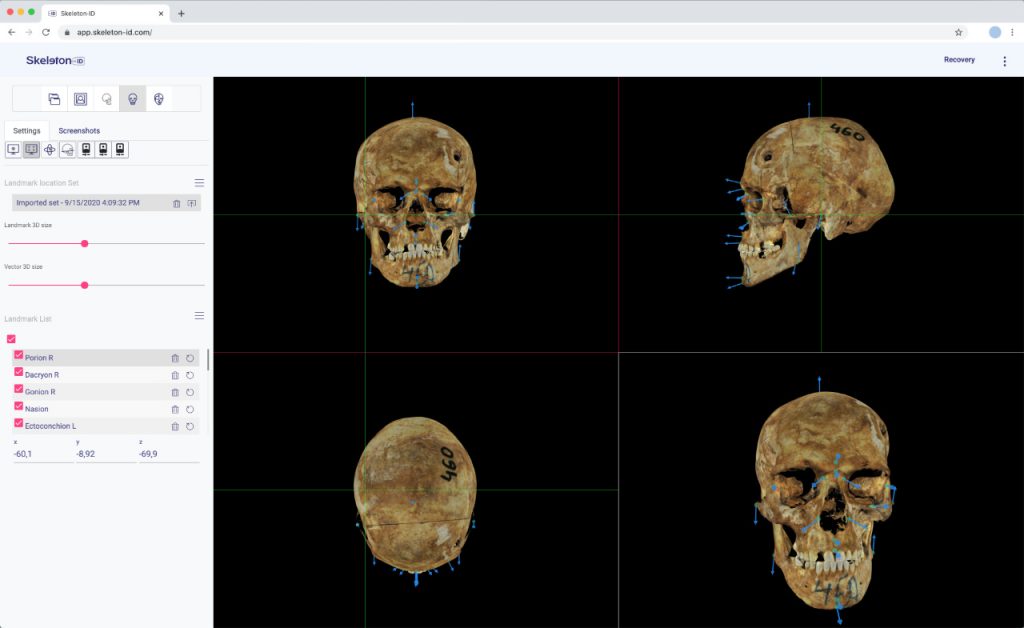International call: validation of semi-automatic Craniofacial Superimposition
Updated on June 24, 2021
Published by Rubén Martos

We are looking for volunteers interested in participating in this study, both experts in craniofacial identification and people with no previous experience. If you are interested in participating or would like more information, please contact us using the button below. [Note: the study ended in early 2023.]

Rubén Martos
Ph. D. Anthropologist

Rosario Guerra
Ph. D. Student in biomedicine
Craniofacial Superimposition
Craniofacial Superimposition (CFS) is probably the most challenging skeletal-based identification method, as it involves overlapping a skull image or 3D skull model with a series of AM facial images of an individual for subsequent analysis of their morphological correspondence. This analysis and a comprehensive/in-depth comparison allow a forensic expert to make decisions on the coherence of the correspondences or discrepancies in the relationship of the osseous and soft tissues, manifested in the positional relationship of anatomical structures, the coherence of contours and shapes of different facial features, the consistency of the soft tissue depth and of any existing asymmetries and unique/individualizing features. After the assessment, and taking into consideration the quality and quantity of the AM and PM materials, a decision on the identification may be reached with a particular degree of support.
Although this technique has been in use for a century, it is currently not possible to make firm statements about the overall reliability of CFS methods because formal published studies of their accuracy and reliability have been rare, they have used small samples and often have not been replicated [Stephan, 2009]
Moreover, the application of the technique involved tedious and manual tasks that relied on the knowledge and experience of the expert, and the evaluation of the correspondences was a subjective and error-prone process. Each expert approached identification problems following their own methodology, developed through trial and error, using the tools and technological means at their disposal, and introducing various sources of error and uncertainty. These issues precluded other experts from verifying the decisions taken regarding identification and seriously hurt the reliability of CFS in the public eye. However, the application of this technique has a low cost and the only AM material required is one or more facial photographs, something easy to obtain nowadays thanks to smartphones and social networks.
The need for objective assessment, involving the conduction of reliability studies and the development of a common methodology, framework, and standards, was alarming. For these purposes, some of the most proficient experts in craniofacial identification methods came together and worked in the MEPROCS EU project, identifying the most common sources of error and uncertainty, defining the requirements of the equipment and tools to be employed in the application of CFS, and detailing a series of “best practices” and “practices to avoid”.
AI-guided Craniofacial Superimposition
In recent decades, AI has made it possible to automate repetitive or tedious tasks for humans ( e.g., the automation of industrial processes or cleaning tasks), as well as to surpass humans in performing complex tasks (for example, the processing of massive amounts of data to extract new knowledge). The CFS technique has not been an exception. Panacea, in collaboration with the University of Granada, has recently developed automatic approaches to accurately locate anthropometric landmarks in facial photographs and 3D skull models, estimate facial pose, subject-to-camera-distance, and soft tissue thickness, automatically perform skull-face overlay and compute a ranking of potential matches for an unknown skull. In addition to these automatic algorithms, Skeleton-ID is the only software on the market that provides all the tools needed by a forensic expert to manually and accurately tackle CFS and come to a final decision.
The validation study
With the aim of validating this technology, we have teamed up with Prof. Erin Kimmerle (the Florida Institute of Forensic Anthropology & Applied Science at the University of South Florida) and J.P. Baraybar (Transregional Forensic Coordinator at the International Committee of the Red Cross) to design a pilot study with contemporary, real-life cases from the former Institute’s donated skeletal collection; and would like to offer the opportunity to participate in this pioneering study to any experts/non-experts willing to do so.

All participants will have access, through Skeleton-ID software, to a set of 30 skull 3D models and a number of AM photographs of the corresponding subjects. Participants will also be provided with automatic landmark locations in both photographs and 3D skulls, and a list of candidates for each skull ranked according to Panacea’s automatic superimposition algorithm. Making use of Skeleton-ID tools, and following MEPROCS standards [Damas et al., 2015], they will be asked to solve the 30 PM vs 30 AM underlying identification problems.
Analysing the results and insights relayed by the participants in this pilot case study will allow us to assess the reliability of the proposed AI-guided methodology while providing the scientific community and forensic practitioners with a replicable validation study of the CFS technique over an unprecedented number of CFS problems, 900 cross-comparisons.
Note that all participants will have free access to Skeleton-ID during the study lifetime, they will be invited to attend a training online workshop and will be provided with training manuals covering all topics of interest for CFS: cephalometric and craniometric landmark location, skull-face overlay as a camera calibration problem, anatomical morphological correspondence analysis, MEPROCS best practices, and Skeleton-ID tools and technology. Results will be submitted to a top scientific journal paper co-authored by all the participants and coordinators of the study.
References
Stephan, CN. Craniofacial identification: techniques of facial approximation and craniofacial superimposition. Handbook of Forensic Anthropogy and Archeaology. (pp. 304-321) edited by Soren Blau and Douglas H Ubelaker. Walnut Creek, CA, U.S.A.: Left Coast Press 2009.
Damas S, Wilkinson C, Kahana T, et al. Study on the performance of different craniofacial superimposition approaches (II): Best practices proposal. Forensic Sci Int 2015; 257: 504–508.
